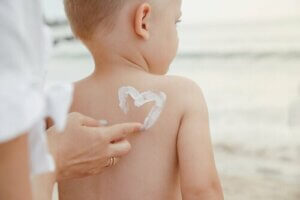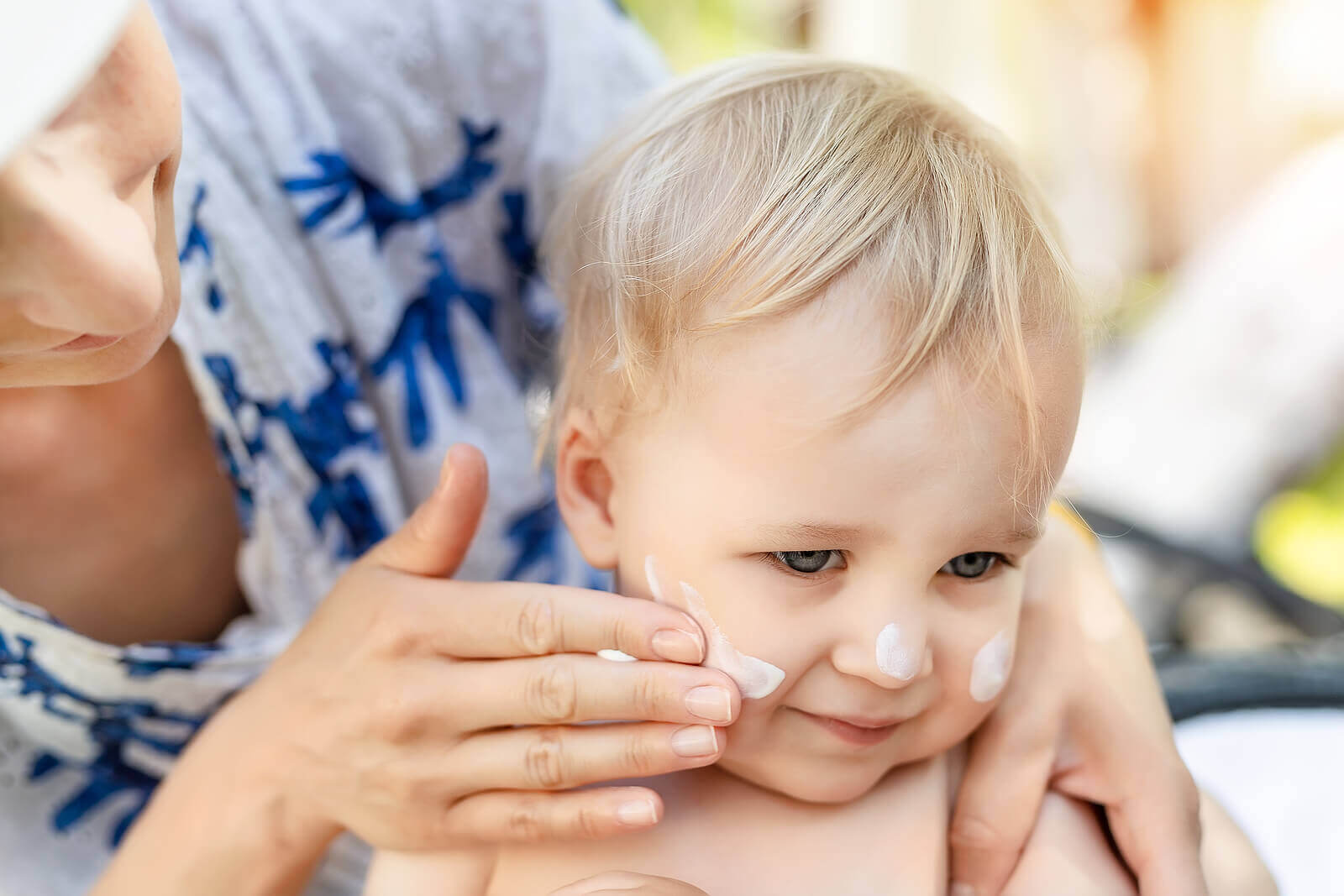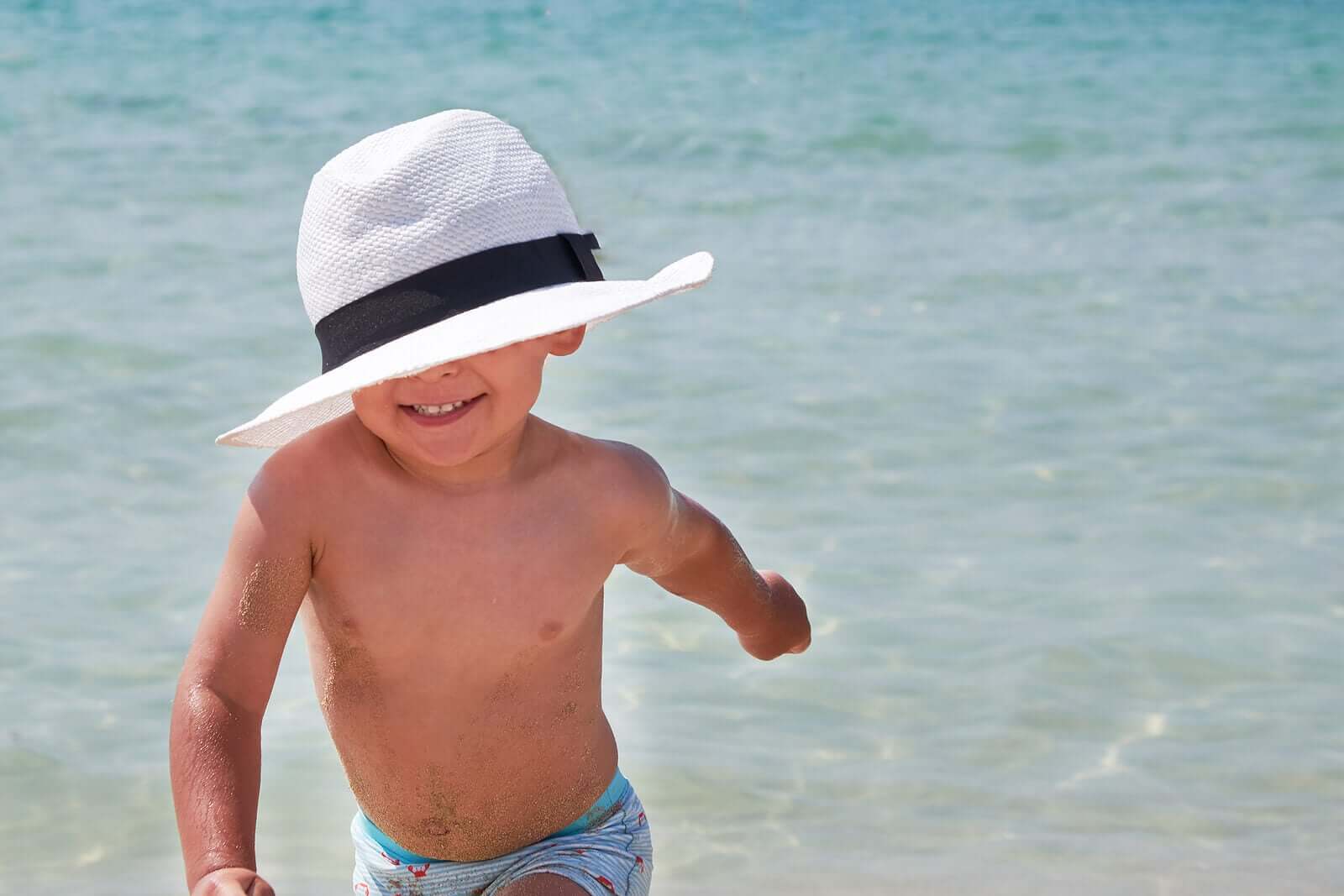Protecting the Skin of Children with Cancer


Written and verified by the dermatologist Maria del Carmen Hernandez
Children with cancer can have skin that’s more sensitive to the sun, as a consequence of the treatments they undergo, such as radiation therapy or chemotherapy.
The skin can burn more easily and the chances of developing some type of malignant lesion, such as melanoma, increase. For this same reason, there are certain precautions to take when it comes to caring for the skin of children with cancer. Here are some measures you should take.
Effects of skin cancer treatments
Chemotherapy drugs cause redness, rashes and different types of skin irritations. Radiation therapy is another procedure that can cause similar signs and symptoms (along with inflammation, peeling of the skin’s surface, and blisters) in the treated region.
Mandatory use of sunscreen on the skin in children with cancer
Children are highly dependent on their parents for sun protection, which makes them a very vulnerable group. There are different forms of sunscreens: Spray, cream, gel, and lotion. However, when it comes to children, the most beneficial is the spray type because of how easy it is to apply.

When choosing a sunscreen, you should focus on those with a broad UVA and UVB spectrum and an SPF (sun protection factor) of 50 or more.
In addition, you should verify the product’s expiration date. Remember that, once opened, the product only lasts for one year.
You may be interested: Sun Protection in Children: What You Should Know
Moisturize the skin constantly
Children who’ve had to undergo therapeutic procedures such as radiotherapy or chemotherapy find themselves with an injured skin surface. Consequently, the skin barrier is altered and must be regenerated.
Proper and regular moisturization is one of the most important steps to implement in the skin of children with cancer. There are even moisturizing creams on the market with sunscreen to combine several of the steps in skin protection.
Wearing wide brimmed hats
The use of wide brimmed hats contributes to the protection of areas of the body that one may forget when putting on sunscreen. The back of the neck, ears and scalp are all protected by this type of measure.
Furthermore, not only should you apply sunscreen on days when the sun is visible, but also on cloudy days. Ultraviolet rays are perfectly capable of making their way through the clouds to damage your skin.
Choosing hypoallergenic products
Hypoallergenic products are known for reducing the likelihood of producing irritations, allergies or intolerances.
Not only is this type of product useful for people with sensitive skin, but for everyone, because no one is exempt from developing an allergic reaction. Hypoallergenic creams, soaps, or shampoos don’t contain any fragrances or dyes that act as allergens on the skin.
Read also: Babies and Children: When to Start Using Sunscreen
Avoiding intense sunshine
Children’s skin is more delicate than that of adults, so it’s important to increase protective measures. This means, for example, staying out of the sun during hours when the sun is most intense and radiation is at its highest. In other words, between 12pm and 4pm.
You should avoid exposure to the sun during these hours or opt for places in the shade. Likewise, you should never expose babies under 6 months old to the sun, even when they have sunscreen on.
Clouds or cloudy days give a false sense that there are no ultraviolet rays that can affect the skin. However, they pass through the clouds and cause the same damage as if the day were sunny.
It should be noted that surfaces such as sand, snow and water enhance the effects of the sun’s rays. Therefore, don’t forget to reapply sunscreen every 2 hours.

Opting for optimal clothing
For skin that is more delicate or that suffers from some alteration in the skin barrier, the choice of clothing is a crucial factor. It’s also preferable to wear 100% cotton garments, with light colors to avoid skin contact with garment dyes.
However, there is a growing range of garments with built-in UV filters. UPF is the rate of penetration of rays through clothing. In fact, the minimum standard UPF for clothing should be 40 to 50+.
Another protective measure to implement is to try to cover the sun-exposed skin surface with clothing.
Importance of protecting the skin of children with cancer
As we’ve just mentioned, it’s essential to follow guidelines regarding skin care and protection measures in children who have cancer. While the above recommendations are for children with cancer in particular, all people should follow these recommendations to protect and care for their skin.
Children with cancer can have skin that’s more sensitive to the sun, as a consequence of the treatments they undergo, such as radiation therapy or chemotherapy.
The skin can burn more easily and the chances of developing some type of malignant lesion, such as melanoma, increase. For this same reason, there are certain precautions to take when it comes to caring for the skin of children with cancer. Here are some measures you should take.
Effects of skin cancer treatments
Chemotherapy drugs cause redness, rashes and different types of skin irritations. Radiation therapy is another procedure that can cause similar signs and symptoms (along with inflammation, peeling of the skin’s surface, and blisters) in the treated region.
Mandatory use of sunscreen on the skin in children with cancer
Children are highly dependent on their parents for sun protection, which makes them a very vulnerable group. There are different forms of sunscreens: Spray, cream, gel, and lotion. However, when it comes to children, the most beneficial is the spray type because of how easy it is to apply.

When choosing a sunscreen, you should focus on those with a broad UVA and UVB spectrum and an SPF (sun protection factor) of 50 or more.
In addition, you should verify the product’s expiration date. Remember that, once opened, the product only lasts for one year.
You may be interested: Sun Protection in Children: What You Should Know
Moisturize the skin constantly
Children who’ve had to undergo therapeutic procedures such as radiotherapy or chemotherapy find themselves with an injured skin surface. Consequently, the skin barrier is altered and must be regenerated.
Proper and regular moisturization is one of the most important steps to implement in the skin of children with cancer. There are even moisturizing creams on the market with sunscreen to combine several of the steps in skin protection.
Wearing wide brimmed hats
The use of wide brimmed hats contributes to the protection of areas of the body that one may forget when putting on sunscreen. The back of the neck, ears and scalp are all protected by this type of measure.
Furthermore, not only should you apply sunscreen on days when the sun is visible, but also on cloudy days. Ultraviolet rays are perfectly capable of making their way through the clouds to damage your skin.
Choosing hypoallergenic products
Hypoallergenic products are known for reducing the likelihood of producing irritations, allergies or intolerances.
Not only is this type of product useful for people with sensitive skin, but for everyone, because no one is exempt from developing an allergic reaction. Hypoallergenic creams, soaps, or shampoos don’t contain any fragrances or dyes that act as allergens on the skin.
Read also: Babies and Children: When to Start Using Sunscreen
Avoiding intense sunshine
Children’s skin is more delicate than that of adults, so it’s important to increase protective measures. This means, for example, staying out of the sun during hours when the sun is most intense and radiation is at its highest. In other words, between 12pm and 4pm.
You should avoid exposure to the sun during these hours or opt for places in the shade. Likewise, you should never expose babies under 6 months old to the sun, even when they have sunscreen on.
Clouds or cloudy days give a false sense that there are no ultraviolet rays that can affect the skin. However, they pass through the clouds and cause the same damage as if the day were sunny.
It should be noted that surfaces such as sand, snow and water enhance the effects of the sun’s rays. Therefore, don’t forget to reapply sunscreen every 2 hours.

Opting for optimal clothing
For skin that is more delicate or that suffers from some alteration in the skin barrier, the choice of clothing is a crucial factor. It’s also preferable to wear 100% cotton garments, with light colors to avoid skin contact with garment dyes.
However, there is a growing range of garments with built-in UV filters. UPF is the rate of penetration of rays through clothing. In fact, the minimum standard UPF for clothing should be 40 to 50+.
Another protective measure to implement is to try to cover the sun-exposed skin surface with clothing.
Importance of protecting the skin of children with cancer
As we’ve just mentioned, it’s essential to follow guidelines regarding skin care and protection measures in children who have cancer. While the above recommendations are for children with cancer in particular, all people should follow these recommendations to protect and care for their skin.
All cited sources were thoroughly reviewed by our team to ensure their quality, reliability, currency, and validity. The bibliography of this article was considered reliable and of academic or scientific accuracy.
- Dadlani C, Orlow SJ. Planning for a brighter future: a review of sun protection and barriers to behavioral change in children and adolescents. Dermatol Online J. 2008 Sep 15;14(9):1. PMID: 19061583.
- Adam J. Sun-protective clothing. J Cutan Med Surg. 1998 Jul;3(1):50-3. doi: 10.1177/120347549800300115. PMID: 9677262.
- Thoonen K, Schneider F, Candel M, de Vries H, van Osch L. Childhood sun safety at different ages: relations between parental sun protection behavior towards their child and children’s own sun protection behavior. BMC Public Health. 2019;19(1):1044. Published 2019 Aug 5. doi:10.1186/s12889-019-7382-0
This text is provided for informational purposes only and does not replace consultation with a professional. If in doubt, consult your specialist.








